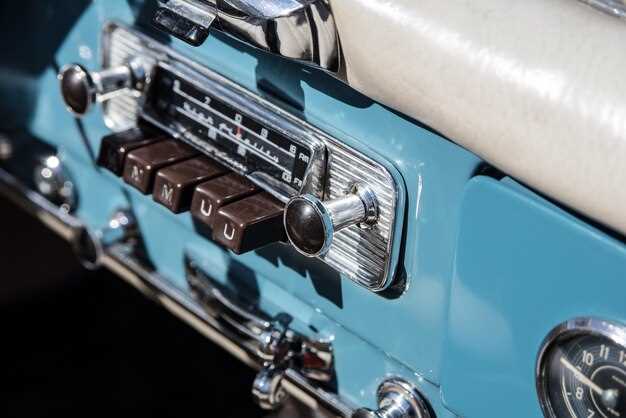
The allure of vintage muscle cars is undeniable, drawing enthusiasts and collectors alike. However, owning a classic vehicle often comes with a set of unique challenges, particularly when it comes to the engine. Over time, various factors can lead to performance issues that not only diminish the driving experience but can also lead to costly repairs if not addressed promptly.
Common engine problems in these classic beauties include oil leaks, overheating, and ignition system failures. Each of these issues can stem from wear and tear, outdated components, or even improper maintenance. Understanding the symptoms and causes of these engine troubles is the first step towards effective repair, ensuring your muscle car continues to roar with the same power it had when it first hit the road.
In this article, we will delve into the most frequent engine issues faced by vintage muscle car owners and provide practical solutions for each problem. With the right knowledge and tools, you can keep your classic muscle car running smoothly for years to come, preserving its legacy and your investment.
Identifying Oil Leaks in Classic Engines

Oil leaks are a common issue in classic engines, often stemming from age, wear, and the materials used in gaskets and seals. Identifying these leaks early is crucial to prevent further damage and expensive repairs. Start by visually inspecting the engine for oil spots, particularly around common leakage areas such as the oil pan, valve covers, and timing cover.
A key method for identifying the source of an oil leak is through the use of a flashlight. Shine the light into the engine compartment, looking for shiny, wet areas where oil might be seeping out. Pay special attention to the rear main seal, oil pan gasket, and any threaded fittings, which can also be prone to leakage.
Another effective technique is to perform a pressure test on the oil system. This involves using a gauge to check for abnormal pressure drops, indicating a potential leak. If a leak is suspected, it can also be helpful to use a leak detection dye that can be added to the oil; when illuminated with a UV light, any leaks will glow, making them easier to spot.
Taking a test drive can also help reveal oil leaks. After driving, inspect the engine area and the ground under the vehicle for any new oil puddles. Be sure to monitor the oil level regularly; a decrease without explanation is an indicator of a possible leak that requires immediate attention.
Addressing oil leaks promptly will not only enhance the performance of a classic engine but will also extend its lifespan. Regular inspections and maintenance are essential in keeping these vintage machines running smoothly and preventing costly repairs down the road.
Understanding Overheating Issues in Vintage Muscle Cars
Overheating is a common concern for owners of classic muscle cars, and it can lead to significant engine damage if not addressed promptly. The mechanics behind overheating can be traced to various factors, including cooling system malfunctions, engine components wear, and driving conditions.
Here are the primary causes of overheating in vintage muscle cars:
- Cooling System Failures: The cooling system is crucial for regulating engine temperature. Key components that can fail include:
- Radiator: Clogs or leaks can impede coolant flow.
- Water Pump: A failing pump can reduce coolant circulation.
- Thermostat: A stuck thermostat can cause the engine to overheat.
- Insufficient Coolant Levels: Low coolant levels can result from leaks or improper maintenance. Regular checking and refilling are essential.
- Engine Timing Issues: Incorrect ignition or valve timing can lead to increased combustion temperatures, contributing to overheating.
- High Load Conditions: Classic muscle cars often face extreme load conditions during performance driving. Heavy acceleration can stress the engine and lead to overheating.
- Old or Deteriorated Components: Vintage engines may have old gaskets, hoses, or seals that need replacement, potentially leading to coolant leaks and overheating.
To mitigate overheating issues, consider the following maintenance tips:
- Regularly check and maintain the cooling system for leaks and blockages.
- Ensure the coolant is topped off and replaced according to the manufacturer’s recommendations.
- Inspect and replace old components such as hoses, gaskets, and the radiator as necessary.
- Monitor the engine timing and adjust as required to ensure efficient combustion.
- Avoid extreme driving conditions, especially in hot weather, to prevent engine strain.
Addressing these issues promptly can help keep your vintage muscle car running cool and preserve the integrity of its classic engine.
Tackling Hard Starting Problems in Classic Engines
Hard starting issues in classic muscle cars can be frustrating and are often indicative of underlying engine problems. Proper diagnosis and repair are essential to restore the vehicle’s performance. Below are common causes and solutions to consider when facing this challenge.
-
Fuel System Issues:
- Clogged Fuel Filters: A clogged filter can restrict fuel flow. Replace the fuel filter to ensure adequate fuel delivery.
- Fuel Pump Failure: Test the fuel pump’s pressure. If it’s below specifications, consider a replacement.
- Old Fuel: Old or contaminated fuel can cause starting problems. Drain and refill with fresh gasoline.
-
Ignition System Problems:
- Worn Spark Plugs: Inspect spark plugs for wear. Replace them if necessary to improve ignition.
- Bad Ignition Coil: Test the ignition coil’s output. If it’s weak, a replacement is required.
- Faulty Ignition Switch: Ensure the ignition switch works properly. If defects are found, repair or replace it.
-
Battery and Electrical Issues:
- Weak Battery: Check the battery voltage. Replace it if it cannot hold a charge.
- Corroded Connections: Inspect battery terminals and cables for corrosion. Clean or replace as necessary.
- Starter Motor Problems: A failing starter motor can hinder engine starting. Test the starter and replace it if it’s faulty.
-
Mechanical Issues:
- Compression Loss: Check for proper compression in cylinders. If low, inspect the engine for wear or leaks.
- Timing Misalignment: Ensure the timing is set correctly. Adjust if necessary to improve performance.
- Oil Viscosity: Use the recommended oil type. Thick oil can impede engine turnover, leading to hard starts.
Addressing hard starting problems in classic engines requires a methodical approach. By troubleshooting these common issues and making the necessary repairs, you can significantly improve the starting reliability of your vintage muscle car.
Diagnosing Carburetor Troubles in Vintage Performance Cars
Carburetors are a crucial component in vintage performance cars, as they manage the air-fuel mixture that powers the engine. Over time, issues can arise, leading to poor performance. Here are common symptoms associated with carburetor troubles and effective repair strategies.
| Symptom | Possible Issue | Repair Approach |
|---|---|---|
| Engine flooding | Stuck float or needle valve | Disassemble the carburetor, inspect the float and valve, clean or replace as necessary. |
| Poor acceleration | Dirty jets or clogged passages | Remove the jets, soak in carb cleaner, and use compressed air to clear passages. |
| Backfiring | Incorrect air-fuel mixture | Adjust the mixture screws and check for vacuum leaks that may affect performance. |
| High idle | Sticking throttle plate | Inspect for throttle linkage issues and clean the throttle plate to ensure smooth operation. |
| Hard starting | Improper fuel delivery | Check fuel pump pressure and inspect the carburetor for leaks or blockage in the lines. |
Maintaining the carburetor in vintage muscle cars is essential for optimal performance. Regular checks and timely repairs can prevent more significant issues down the road. Understanding these symptoms and their causes empowers enthusiasts to restore their classic cars to their former glory.
Fixing Ignition System Failures in Classic Muscle Cars

The ignition system is a crucial component in the performance and reliability of classic muscle car engines. Over time, various parts of the ignition system may fail, leading to poor engine performance or complete failure to start. Common issues include faulty spark plugs, worn ignition coils, and malfunctioning distributors.
Spark Plugs: One of the simplest fixes is replacing worn or fouled spark plugs. Old plugs can cause misfires and reduce engine efficiency. Regular inspection and replacement are essential to maintaining optimal performance. Ensure that the correct type of spark plug is used, adhering to the manufacturer’s specifications for your specific engine.
Ignition Coils: If the engine is experiencing hesitation or rough idling, the ignition coils may be at fault. These coils convert battery voltage into the high voltage needed to create a spark. A multimeter can be used to check the resistance of the coils. If they are outside the specified range, replacement is necessary to restore proper function to the ignition system.
Distributors: The distributor plays a critical role in directing the spark to the correct cylinder. Faulty points or a worn rotor can lead to erratic ignition timing. Inspecting and cleaning the distributor components or replacing them entirely can help resolve these issues. Furthermore, ensuring that the timing is correctly set is vital for optimal engine performance.
In addition to replacing faulty components, checking for loose connections and ensuring that wiring is in good condition is essential. Corroded terminals can hinder performance, so cleaning and securing connections can prevent ignition failures.
Regular maintenance and timely repairs of the ignition system not only enhance engine performance but also contribute to a smoother driving experience in classic muscle cars. Familiarity with these common failures and their respective fixes can help enthusiasts keep their vehicles in peak condition.
Addressing Exhaust Smoke Issues in Vintage Engines
Exhaust smoke is a common issue many owners of classic muscle cars face, often indicating underlying problems with the engine. The color of the smoke can provide essential clues about the specific issue at hand. Understanding these nuances is crucial for effective diagnosis and repair.
Blue smoke typically signifies that engine oil is being burned along with fuel. This could be due to worn piston rings, valve guides, or seals. In a classic engine, replacing these components may involve significant labor, but it is vital to maintain performance and prevent further damage.
White smoke is often indicative of coolant entering the combustion chamber, usually a result of a blown head gasket or a cracked engine block. For vintage engines, this issue demands immediate attention to avoid catastrophic engine failure. Repairing or replacing a head gasket can be complex, and it is advisable to gauge the overall health of the engine during this process.
Black smoke indicates an overly rich fuel mixture, which can stem from a malfunctioning carburetor or fuel injection system. Classic cars often feature carbureted systems, so tuning these components or replacing them may resolve the issue. Ensuring the proper air-fuel ratio is fundamental for optimal engine performance.
Regular maintenance and timely diagnostics are essential for addressing exhaust smoke issues in vintage engines. Engaging with experienced mechanics who specialize in classic automobiles can lead to more effective repairs and enhance the longevity of these cherished vehicles. Taking proactive measures now can prevent more severe problems in the future.




